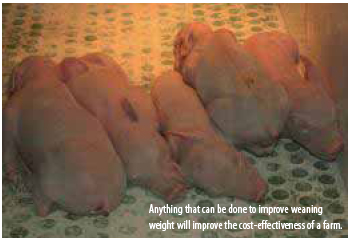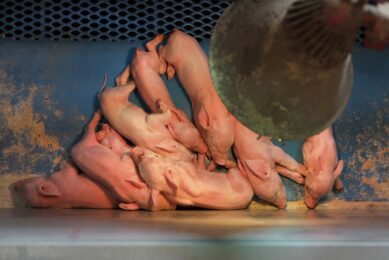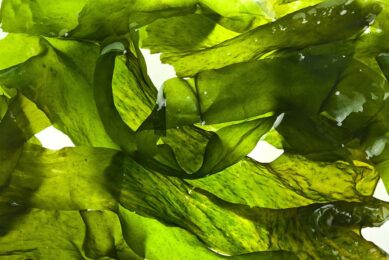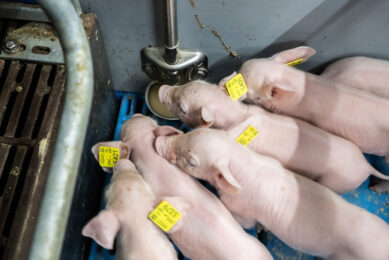Piglets performing better with yeast during lactation

All pig producers around the world strive for the same objective of maximising performance at the lowest cost/ kg thereby producing the best return per pig. This is the everyday question posed to nutritionists and the initial focus of attention is often on the sow and nursery production systems. It is these areas of production that small adjustments in the lactating sow and nursery systems can have dramatic impacts on lifetime performance.
Weaning weight has always been important in determining pig performance but targeting a better weaning weight is also becoming more critical as more pigs/ sow/ year means more variable birth and weaning weights. With improvements in management, restocking and improved genetics there has been a steady year on year increase in the number of pigs weaned per sow per year globally over the last five years (shown in Figure 1). One of the areas of concern with bigger litter sizes is possible lower birth weights and lower weaning weights which has a further impact on lifetime performance. Recent work by Kansas State University researchers (2009) on over 2,000 pigs showed the effect of litter size on birth weight categories (%) and how the percentage of small pigs (<1 kg) increases with larger litter size while the percentage of heavier pigs (>2 kg) decreases (Figure 2).
One consequence of having an in-creased number of smaller pigs in the litter is that the subsequent weaning weight is often reduced. In this particular work the results showed that although litter weight at weaning increased, individual weaning weight was reduced by 0.5 kg when litter size increased from 11 to 15 pigs per sow.Assuming that a loss of 0.5 kg in weaning weight equates to a loss on average of 2 kg at slaughter then this results in the producer losing out on potential income through poorer weaning weights. It is therefore a focus of swine production systems to both increase the number of pigs weaned per sow per year and to maintain or improve weaning weights whilst at the same time reducing pre-weaning mortality.
Lactation nutrition
More emphasis has been placed on lactation nutrition over the last few years with a focus on ways to improve the weaning weight and reduce pre-weaning mortality. This becomes more important in the summer months when warmer temperatures drive down lactation feed intake resulting in a subsequent drop in weaning weight. This seasonal problem can be compounded further by poorer quality corn as seen in the USA in 2010. Any measures that can therefore be employed during this period to improve weaning weights is critical.
The impact of the small pigs born on subsequent nursery performance was investigated by Purdue University researchers. This study projected growth for each of five 20 percentile groups (PCT) from birth and weaning through to the end of the nursery period at 60 days of age. The results confirm that the top 80% of pigs have a similar average daily gain (ADG) up to day 60 while the bottom 20% of the pigs have a dramatic fall off in late nursery performance with time.
This difference will continue to grow over the lifetime production of the pig and it is therefore important to treat, where possible, the bottom 20% of the pigs as a separate population. A proactive approach such as treating these bottom 20% as a separate population would minimise the negative impact that they have on the production system as a whole. Weaning weight is important in improving post-weaning performance. Three trials looking at weaning weight impact on subsequent nursery growth showed that an extra 1 kg improvement in weaning weight improved growth through the nursery by approximately 36 g a day. Not only is the benefit seen through the nursery but also through the finishing units, Cooper reported in 2001 that 1 kg extra at weaning resulted in 4.2 kg at 20 weeks of age. It is therefore important for pig producers to review their lactation nutrition and determine the economic feasibility of improving this nutrition to improve weaning weight with the potential return per pig.Although there are many factors that can impact weaning weight including management, environment, sow nutrition and genetics of the sow, this article focuses on the use of live yeast during lactation to improve weaning weight.
Live yeast
Live yeast is a probiotic that has been used extensively in the dairy market to improve dry matter intake and milk production. This has been attributed to the ability of a live yeast to scavenge oxygen from the rumen thereby providing the ideal anaerobic environment for beneficial bacteria growth. The beneficial bacteria improve nutrient utilisation and milk production. In sows it is well documented that live yeast is often fed through gestation to improve birth weights but this paper focuses on the use of live yeast during lactation to produce a heavier weaned piglet and reduce pre-weaning mortality. Research conducted on a commercial live yeast product (Vistacell, AB Vista) in the USA and Europe has shown the impact that a live yeast can have on weaning weight and pre-weaning mortality when applied through the lactation stage.
In the US study, the research looked at live yeast supplementation through an 18-day lactation period. The results showed that the pre-weaning growth rates of piglets suckling on sows fed live yeast were improved by 6% over control piglets (0.30 kg extra in weaning weight). In addition, piglets on the live yeast fed sows had a reduced pre-weaning mortality compared to the control piglets born on the sows fed no live yeast. This reduced pre-weaning mortality in the live yeast fed sows resulted in an extra 0.5 pig per weaning. This study shows that live yeast may assist the farmers and nutritionists in their struggle towards increasing the number of pigs weaned per litter while maintaining or increasing weaning weight, which will encourage subsequent lifetime performance.
European work showed that for later weaned pigs (>21 days), pre-weaning growth rate was increased (+12%) and there was an extra 0.4 piglet weaned when sows were fed live yeast through the lactation period. Based on three trials the average weaning weight gain was +0.86 kg per pig. Overall the results showed (Table 1) that the use of a live yeast improved average weaning weights by 0.73 kg while increasing the number of pigs weaned by 0.42 pigs per litter. The results also indicate that the effect, as you would expect, is greater in longer lactation periods (>21 days) than shorter lactation periods (<21 days) but even the shorter lactation periods showed a positive response in early weaned piglets.
Benefiting suckling piglets
There are differing mechanistic reasons why live yeast benefits the sow and suckling piglets, but essentially the live yeast is optimising sow gut health thereby improving nutrient utilisation and producing an improved milk composition and/ or output.
• Research conducted internally showed that similar to yeast cell wall components, live yeast is effective in reducing the pathogenic load on the gastrointestinal tract, like e.g. Salmonella enterica and E.coli K88. This will assist in promoting ‘beneficial’ bacteria in the gut and will reduce the maintenance energy cost of the pig.• It is suggested that the use of live yeast will also alter the gut micro-environment increasing the presence of cellulytic bacteria in the hind gut. This will improve hind-gut fermentation and a higher production of volatile fatty acids (VFAs) which can be utilised as an energy source by the sow which will improve efficiency.
• Research from 1995 showed that the use of live yeast improved the nutrient composition of the milk, as the use of live yeast in lactation improved milk protein by 7% and fat by 14%.
• It has been well documented that live yeasts can impact the immune status of the animal. Immune factors like CD4 and CD8 levels have been noted to go up in a recent trial in the USA. These levels essentially monitor the immune system of the body and react if an infection occurs.
• Improving gut health by the use of live yeast in the sow can improve lactation feed intake. Trials have shown that the use of a live yeast can stimulate feed intake with improvements between 3 to 14% of the standard lactation feed intake without live yeast. References available upon request.
 Beheer
Beheer








 WP Admin
WP Admin  Bewerk bericht
Bewerk bericht